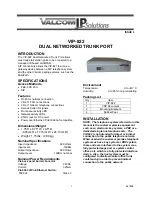
254
MTunnel address: 1.1.1.3
Multi-AS MD VPN configuration example
Network requirements
Item Network
requirements
Multicast sources
and receivers
•
In VPN a, S 1 is a multicast source, and R 2 is a receiver.
•
In VPN b, S 2 is a multicast source, and R 1 is a receiver.
•
For VPN a, the share-group address is 239.1.1.1, and the range of its
switch-group-pool addresses is 225.1.1.0 to 225.1.1.15.
•
For VPN b, the share-group address is 239.4.4.4, and the range of its
switch-group-pool addresses is 225.4.4.0 to 225.4.4.15.
PE interfaces and
VPN instances they
belong to
•
PE 1—Ethernet 1/2 belongs to VPN instance
a
. Ethernet 1/3 belongs to VPN
instance
b
. Ethernet 1/1 and Loopback 1 belong to the public network instance.
•
PE 2—Ethernet 1/1, Ethernet 1/2, Loopback 1 and Loopback 2 belong to the public
network instance.
•
PE 3—Ethernet 1/1, Ethernet 1/2, Loopback 1 and Loopback 2 belong to the public
network instance.
•
PE 4—Ethernet 1/2 belongs to VPN instance
a
. Ethernet 1/3 belongs to VPN
instance
b
. Ethernet 1/1 and Loopback 1 belong to the public network instance.
Unicast routing
protocols and MPLS
•
Configure OSPF separately in AS 100 and AS 200, and configure OSPF between
the PEs and CEs.
•
Establish BGP peer connections between PE 1, PE 2, PE 3 and PE 4 on their respective
Loopback 1 and exchange all VPN routes between them.
•
Configure MPLS separately in AS 100 and AS 200.
IP multicast routing
•
Enable IP multicast routing on the public network on PE 1, PE 2, PE 3 and PE 4.
•
Enable IP multicast routing in VPN instance
a
on PE 1 and PE 4.
•
Enable IP multicast routing in VPN instance
b
on PE 1 and PE 4.
•
Enable IP multicast routing on CE a1, CE a2, CE b1, and CE b2.
IGMP
•
Run IGMPv2 on Ethernet 1/1 of CE a2.
•
Run IGMPv2 on Ethernet 1/1 of CE b2.
PIM
•
Enable PIM-SM on all public network interfaces of PE 2 and PE 3.
•
Enable PIM-SM on all public and private network interfaces of PE 1 and PE 4.
•
Enable PIM-SM on all interfaces of CE a1, CE a2, CE b1, and CE b2.
•
Configure Loopback 2 of PE 2 and PE 3 as a C-BSR and a C-RP for their respective AS
(to work for all multicast groups).
•
Configure Loopback 0 of CE a1 as a C-BSR and a C-RP for VPN a (to work for all
multicast groups).
•
Configure Loopback 0 of CE b1 as a C-BSR and a C-RP for VPN b (to work for all
multicast groups).
MSDP
•
Establish an MSDP peering relationship between PE 2 and PE 3 on their respective
Loopback 1.
















































